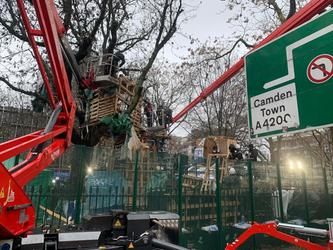Squatter evictions and mental health

There may be many reasons why a group of people decide to occupy empty property; perhaps to protest the planned conversion of that site into another use, to live somewhere for free or maybe to prevent homelessness.
We sometimes find that some of the squatters will be suffering from a range of mental health issues. We have contact details for the relevant people to assist, such as Social Services, so that we can promptly call them in when required.
More often, though, it is a case of training and awareness of what to look for and how to defuse potential situations as they arise. In this article we look at the likely scale of the challenge, how we deal with it and some real life examples.
Prevalence of mental health issues among squatters
The Royal College of Psychiatrists estimates that one in four people across the general population suffers from some form of mental ill health.
Other studies show also that there is a clear link between mental health and homelessness. Whilst homelessness is not the sole cause of squatting, the statistics on the prevalence of mental health issues amongst the homeless give an indication that there will most probably be a higher level of mental health issues amongst squatters than in the general population.
Research by the Lankelly Chase Foundation has shown that there is a huge overlap between offending, substance misuse and homelessness. They estimate that there are 58,000 people in the UK experiencing all three and that 55% of those have a diagnosed mental health problem.
The Homeless Link audit in 2014 found that 80% of homeless people in England reported that they had mental health issues, with 45% having been diagnosed with a mental health condition.
In a report in 2012, the Department for Communities and Local Government found that the most prevalent health problems among homeless individuals are:
- Substance misuse - 62.5%
- Mental health problems - 53.7%
- A combination of the two - 42.6%
How to handle squatters with mental health issues
Perhaps the most important aspect is thorough training on how to identify vulnerability and mental health in the people we are dealing with. This will include looking out for verbal and body language cues. Sometimes it may be immediately apparent, but this is not always the case.
We also train our teams on violence and conflict management, so that they are equipped to defuse and reduce conflict to prevent escalation.
The final part is rigorous risk assessment and planning to ensure we are prepared in advance and have taken into account all the known facts. Our agents are also skilled at dynamic risk assessment on the job, which is where the training kicks in.
Real life case studies
The man with no name
Whilst removing approximately 40 squatters from land in Camden Town, we found a protester in a tent who refused to leave.
He was well-spoken but it quickly became clear that he was suffering from mental health problems. He appeared to be paranoid and our agents were concerned that he was about to self-harm.
The man told our agents that he had declared that this land was an independent state and would not recognise English law, claiming that our team wanted to “kill and exile” him. He said that he had long ago refused to use a name, which meant no one could help him.
He listed multiple physical health conditions but that no one could help him. He also claimed to be able to read minds and projected energy from our agents, energy which he found to be negative.
We removed him from the site in a calm and safe manner, which prevented any further incidents. This eviction was featured in an episode of The Sheriffs Are Coming, which you may be able to find on YouTube (season 6, episode 4).
In the line of fire
In a separate incident, during a large eviction, a protester had climbed a tree, poured petrol over himself and the surrounding branches and was threatening to set fire to himself. We brought the Police and Fire Brigade on site and worked with them to develop a plan to handle the situation.
One member of our specialist climbing team went up the tree and secured the protester with a rope. This meant that, when he threw more petrol around and lit the match, our climber was able to knock him out of the tree, manage his controlled descent to the ground, where the Fire Brigade was ready and waiting to extinguish the flames straight away.
Because the flames were put out so quickly, the protester only sustained very minor burns and our climber, who could easily have caught on fire too, was safe and uninjured.



